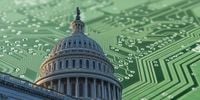President Donald Trump’s latest move on semiconductor exports has sent shockwaves through Washington and Silicon Valley alike, thrusting Congress into the spotlight and reigniting fierce debate over the future of American technology policy. On August 17, 2025, the Trump administration unveiled a controversial policy: the government would take a 15% cut from sales of certain Nvidia and AMD artificial intelligence chips to China. This decision, according to reporting by multiple outlets, has upended what was already a heated conversation about national security and global tech competition.
For months, lawmakers, business leaders, and national security experts have wrangled over whether U.S.-made AI chips should even be available for export to China. The stakes are sky-high: these chips, developed by industry giants Nvidia and AMD, power everything from facial recognition to advanced military systems. As a result, critics have warned that selling them to China could tip the balance of technological power and compromise American security interests.
But President Trump’s policy didn’t just fuel this debate—it added a new, combustible element. By demanding a 15% cut on chip sales, the administration effectively imposed what many are calling an “export tax”—a move that has drawn fire from both sides of the aisle and raised profound constitutional questions.
According to an editorial published on August 12, 2025, and cited by The Wall Street Journal, the president’s demand for a 15% cut from Nvidia and AMD’s China-bound sales was characterized as “an export tax that Congress didn’t authorize.” That’s a serious charge, and it’s one that legal scholars have been quick to amplify. Em. Prof. Erik M. Jensen, writing in the same editorial, argued that the U.S. Constitution’s Export Clause leaves no room for ambiguity: “No Tax or Duty shall be laid on articles exported from any State.” In other words, Congress itself couldn’t impose such a tax, and—crucially—can’t simply authorize the executive branch to do so either.
“The taxing power under the Constitution is Congress’s, but the Export Clause provides that ‘No Tax or Duty shall be laid on articles exported from any State.’ No exceptions,” Jensen wrote, laying out the legal argument in stark terms. “Congress itself therefore couldn’t impose a tax on exports, and it should follow that Congress can’t wave a magic wand to turn an unconstitutional act by the executive into a constitutional one.”
This legal wrinkle has placed Congress in an awkward and, some argue, untenable position. Lawmakers are now faced with a policy that many see as both politically explosive and legally dubious. The Trump administration’s move, intended to assert U.S. leverage in the global chip market and extract revenue from booming exports, may instead be setting the stage for a constitutional showdown.
The heart of the controversy, of course, is about much more than legal technicalities. The semiconductor industry sits at the crossroads of economics, national security, and technological innovation. Nvidia and AMD, two of America’s most valuable and innovative companies, have invested billions in developing AI chips that are now at the center of global competition. China, eager to close the gap with the West, has been a voracious customer. But as tensions between Washington and Beijing have grown, so too have calls to restrict or even ban chip exports to China altogether.
According to industry analysts and security hawks, allowing these exports risks giving China the technological upper hand in critical sectors. “It had mostly been about whether the chips should be sold to China at all due to national security concerns,” noted a recent report by Reuters. The Trump administration’s 15% cut, then, is seen by some as a compromise—an attempt to allow sales while extracting a financial benefit for the U.S. government. But for others, it’s a bridge too far, both constitutionally and strategically.
Business leaders have responded with a mix of alarm and confusion. For Nvidia and AMD, the policy threatens to upend their business models and sow uncertainty in a market already rattled by trade tensions. Investors, too, have reacted nervously, with shares in both companies dipping on news of the new policy. The prospect of a government-imposed levy on exports has raised questions about the future profitability of chip sales to China and, more broadly, about the predictability of U.S. trade policy.
On Capitol Hill, reactions have been swift and divided. Some lawmakers, particularly those with national security backgrounds, have argued that the administration’s move doesn’t go far enough. They want outright bans on the sale of advanced chips to China, citing the risk that American technology could be used to bolster Chinese military capabilities. Others, especially those representing districts with large tech employers, have warned that the policy could backfire by pushing China to accelerate its own chip development and shut American firms out of a lucrative market.
Legal experts, meanwhile, are sounding the alarm about the constitutional implications. The Export Clause, embedded in Article I, Section 9 of the Constitution, was designed to prevent the federal government from interfering in the free flow of American goods abroad. Historically, it has been interpreted strictly, with the Supreme Court repeatedly striking down attempts to tax exports. The Trump administration’s 15% cut, critics argue, flies in the face of this long-standing precedent.
“Such authorization would be irrelevant here,” Jensen wrote, underscoring the point. “The charge almost certainly would be considered a tax, and Congress didn’t authorize it.” For constitutional purists, the policy represents an unprecedented overreach by the executive branch—one that could set a dangerous precedent for future administrations.
Yet the political calculus is anything but straightforward. With China racing to build its own semiconductor industry, some in Washington see the 15% cut as a way to slow Beijing’s progress while boosting U.S. coffers. Others worry that the policy could invite retaliation or prompt legal challenges that would tie up the courts for years.
For now, the fate of the policy—and the broader question of U.S.-China tech relations—hangs in the balance. Congress faces mounting pressure to act, whether by challenging the administration’s authority, clarifying the law, or crafting a new approach to semiconductor exports. The stakes could hardly be higher: at issue are not just billions of dollars in sales, but the future of American technological leadership and the delicate balance of power in the 21st century.
As the debate rages on, one thing is clear: President Trump’s 15% export cut has forced Congress, the courts, and the American public to confront fundamental questions about the Constitution, the economy, and the nation’s place in a rapidly changing world.




